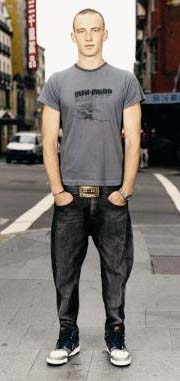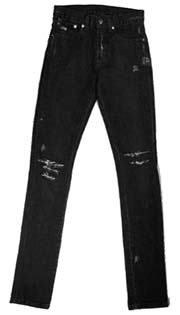|
fashion: feature
 All in the jeans All in the jeans
continued
Furthermore, with globalization has come the
realization we are all citizens of the world. While the dominance
of the USA is still hard to refute,
in true denim democracy, global influences are beginning to prevail.
In 1999, Levi’s released a collaboration with Droog, a Dutch design
collective that usually focuses on furniture and architectural elements.
Another initiative took inspirations from the streets of Tokyo,
with a jean named the ‘Carrot’ cut. The ‘Carrot’ sits comfortably
within the context of Japanese street culture, but internationally
was never released. Although it may indeed be a gesture from what
is undoubtedly a highly commercial corporation, fashion is an industry
reliant on the mood of the consumer. The majority of the reasons
we buy clothing are superfluous to our needs. With the changes in
pop culture being as they are, large companies have to do a far
sight more listening, as opposed to dictating to the market.
Then there is a backlash against the idea of
pop culture itself. New Zealand label Stolen Girlfriends’ Club is
part of the movement that raises a finger to the establishment.
With the use of some clever satire, and cheeky slogans and oversized
T-shirts as their weapon of choice, nothing is safe. Targets include
Marc Jacobs, the Eiffel Tower and guitar picks. Even religious imagery
has got a look in. They have gained momentum, and their denim, in
particular, has come into its own this season.
Their current collection, This is Not a Threat
… Just a Warning, features jeans that perhaps could be better
described as denim leggings. While other brands are moving away
from the deconstruction that has dominated over the last few seasons,
SGC features the perfect amount of
ripped knee, reminiscent of Vivianne Westwood and the Ramones.
They are part of the larger æsthetic movement
that battles against the uniformity of fashion. Marc Moore is one-third
of the design team behind the label, and believes ‘We are probably
more focused on the æsthetic rather than function.’ This could be
deducted by the pair of skinny PVC
pants, which, unfortunately, fall out of the jurisdiction of this
article. Hitting the nail on the head for a young audience that
blows every dollar on crazy fashion affords this luxury. Their clothing
speaks in identity, not branding. ‘We are not big fans of branding
on the outside of jeans. We love understated details.’ Presumably
not referring to the PVC pants; however,
could it be that in the swing in the other direction, we have found
an appreciation of dress as objects that talk about us, rather than
what label is hanging out from behind the pocket?
Denim has typically been fuelled by branding.
The significance of the label has been mistaken for, or seems to
equate to, an identity in itself. The reactionary movement to this
is what Melbourne denim collective Nobody is about. Sourcing denim
from Japan and hand-customizing each pair in the laundry, individuality
and anonymity are currency over status and notoriety. ‘We are just
doing what we love, and not bullshitting about it, through advertising
and constructed images. Because that is irrelevant.’
As each label finds its own niche and voice,
Workshop, the matriarch of New Zealand denim, as always, delivers
on silhouette. For this winter they are carrying a skinny leg through
to a low slouch jean, and a high-waist flare for those who are game.
They do rest firmly on the dark side of denim, bypassing any distressing
or washes. It’s entirely consistent with everything happening overseas,
but, as a result, have a limited choice in colour.
Lee is also producing very blue denim, with its
new campaign, ‘Clean’. It
sums it up as keeping it simple, steering right away from the kind
of distressing and washes that have dominated over the last few
seasons. Levi’s can always be relied on for variety of cut and colour,
all your bases covered within one shelved wall of denim heaven.
Wrangler also is doing some great variety of cut and colour.
While all the major brands continue to offer
a wide range, it is clear that denim is going back to basics. It’s
all about Indigo you can get lost in, with an aversion to washes
and distresses. This is also a bonus for Mother Nature as well—anyone
with an environmental conscience should always steer away from enzyme
washes and chemical treatments. It also means you can get more wear
about of your purchase—distressed jeans can often be a liability.
If you purchase them with holes in them to begin with, there is
no telling how they will end up in a year’s time. And while revealing
in a bit of refreshing simplicity, pick up what’s on offer for clever
detailing on pockets, zips, belt loops and rivets.
The other overall trend that affects our denim
consumer habits is that, recently, jeans have worked their way up
the social order of garments. It can now be incorporated as part
of a formal outfit. As a teenager, there was never a pub without
a ‘No black jeans’ sign on the door. Even taking into account that
I was from Hamilton, if I ever cared to go back there I would be
fascinated to see if they survive with our current enthusiasm for
stovepipes. Dave Byrne, from Hurricane
Jeans, has sold jeans for 18 years. He maintains that, currently,
if you are to be denied entry out on the town, it will be your shoes
and collar that will be the first targets. Your jeans may be third
on the list, but really only if they are looking for a reason to
get rid of you.
As a result, people are buying jeans like never
before. There is very little alternative on the market without upgrading
formal or work wear. All of this enforces the shuffling where every
brand finds its niche and identity, where people align themselves
with the æsthetic of the brand. There may no longer be a clear mainstream,
but anonymous jeans with no visible branding will take their place
alongside the jeans with branding like there is no tomorrow, because
both customers exist simultaneously.
No one could have predicted that a uniform for
coal miners in the pioneering US would
turn into a fashion icon. The narrative of denim is one that marries
the conformity of fashion with an anti-establishment sentiment.
Denim, all at once, has connotations of a struggling working class,
but survives simultaneously as a status symbol. It began as the
all-American hero, morphed into an enfant terrible, and now exists
as a complete fashion food group. It is loaded with cultural meanings,
many of them contradictory, some of them hard to swallow. But when
the masses speak, even a garment can be elevated to cultural icon
status. Pop culture may be guilty of various crimes, but jeans certainly
aren’t one of them. •
See
the original 4 pp. article in Lucire issue 23.
Add
to Del.icio.us | Digg
it | Add
to Facebook
|


Above from top: Levi’s Carrot cut, 2006. Stolen
Girlfriends’ Club jeans.
Denim has typically been fuelled by branding.
The significance of the label has been mistaken for, or seems to
equate to, an identity in itself
|

